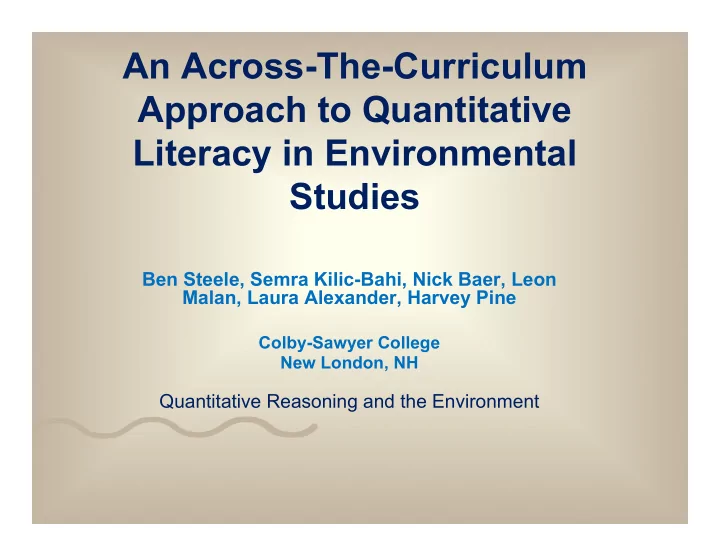

An Across-The-Curriculum Approach to Quantitative Literacy in Environmental Studies Ben Steele, Semra Kilic-Bahi, Nick Baer, Leon Malan, Laura Alexander, Harvey Pine Colby-Sawyer College New London, NH Quantitative Reasoning and the Environment
Need for Quantitative Skills • Understanding issues • Careers • Informed citizenry • Environmental Studies and Environmental Science
Across the Curriculum Approach • Encounter different skills and different applications throughout the curriculum • Use skills in context – Learning advantage – Habit of mind – But hard to ensure students get all skills – Harder to assess
Skills • Basic arithmetic – Proportion; percent – Unit conversions – Rate of change • Data presentation and analysis – Error – Graphing Average Percent of Leaf 44 42 – Descriptive statistics 40 Missing 38 36 34 32 30 Sugar maple White Birch (alone) (clumped)
Skills (cont.) Both species P • Algebra; Modeling R 600 500 Population – Manipulating equations 400 300 200 – Linear and non-linear functions 100 0 – Modeling 0 50 100 • Geometry; Trigonometry – Circles – Squares, rectangles, Triangles – Trigonometric functions – Spheres – Cubes and other solid figures
Curriculum Grid Env. Science Aquatic
Curriculum Grid Env. Science Terrestrial
Curriculum Grid Env. Studies
Examples: BIO 107 Ecology • Data collection and presentation • Preference of Fall Web Worms for maple versus cherry leaves • Spreadsheets, means, standard errors, graphs 0.5 DISH ¡ LEAF ¡ WEIGHT ¡BEFORE ¡WEIGHT ¡AFTER ¡CONSUMPTION ¡ 0.45 1 ¡ MAPLE ¡ 0.2462 ¡ 0.1023 ¡ 0.1439 ¡ amount consumed (g) 2 ¡ MAPLE ¡ 0.2369 ¡ 0.104 ¡ 0.1329 ¡ 0.4 3 ¡ MAPLE ¡ 0.3533 ¡ 0.164 ¡ 0.1893 ¡ 0.35 4 ¡ MAPLE ¡ 0.6266 ¡ 0.267 ¡ 0.3596 ¡ 0.3 5 ¡ MAPLE ¡ 0.4436 ¡ 0.2132 ¡ 0.2304 ¡ 0.25 6 ¡ MAPLE ¡ 0.5503 ¡ 0.1731 ¡ 0.3772 ¡ 0.2 7 ¡ MAPLE ¡ 0.3624 ¡ 0.1201 ¡ 0.2423 ¡ 0.15 8 ¡ MAPLE ¡ 0.3173 ¡ 0.1583 ¡ 0.159 ¡ 0.1 9 ¡ MAPLE ¡ 0.3436 ¡ 0.1343 ¡ 0.2093 ¡ 0.05 10 ¡ MAPLE ¡ 0.7392 ¡ 0.3976 ¡ 0.3416 ¡ 0 Average ¡ 0.23855 ¡ Maple Apple std ¡dev ¡ 0.090864114 ¡ std ¡error ¡
Examples: ENV 201 Water Resources • Quantifying Stream Discharge 0 .5m 1m 1.5m 2m 2.5m 2.9m – Area calculations – Unit conversions – Data management – Spreadsheet skills – Graphing
Examples: BIO 318 Terrestrial Ecology • Matrix model using survival and reproduction in several age classes. • Stable population and age classes • Effect of survival at different ages total pop Matrix ¡ 0 ¡ 1 ¡ 2 ¡ 45 40 0.5 ¡ 0 ¡ 0 ¡ 35 0 ¡ 0.5 ¡ 0 ¡ 30 year ¡1 ¡ year ¡2 ¡ year ¡3 ¡ year ¡4 ¡ year ¡5 ¡ year ¡6 ¡ 25 10 ¡ 30 ¡ 15 ¡ 20 ¡ 22.5 ¡ 17.5 ¡ 20 15 10 ¡ 5 ¡ 15 ¡ 7.5 ¡ 10 ¡ 11.25 ¡ 10 10 ¡ 5 ¡ 2.5 ¡ 7.5 ¡ 3.75 ¡ 5 ¡ 5 total ¡ 0 30 ¡ 40 ¡ 32.5 ¡ 35 ¡ 36.25 ¡ 33.75 ¡ pop ¡ 1 2 3 4 5 6 7 8 9 10 11 12 13 14 15 16 17 18 19 20
Does it work: Evaluation • Overall: Basic Q skills and QL skills tests
Does it work: Evaluation • Pre/post test on module 4 3.5 3 2.5 Grade 2 1.5 1 0.5 0 Pre test Post Test End of semester
Challenges • Only one example of a skill: low retention • Hindered by basic skills Task 1. If the island is 267 ha and each bird needs 0.1 ha, what is the maximum population? (A hectare is 100m by 100m)
Challenges: basic skills (cont.) • Now design an experiment to answer the question: – Is it better for a one year old to produce more young or to put their energy into survival? Start by reducing the survival of one year olds by 10% and see what % change in fecundity is required to recreated a stable population.
Challenges: basic skills (cont.) • Extra credit: – What is 10% less than 0.7? – What is 20% less than 200 – What is 5 % more than .01 • Average = 1.7, Range 0-3 • Lack of practice? • Used to calculators?
Conclusions • Quantitative Literacy skills are weak • Across the curriculum makes sense – But does it work? • Projection – Students need to encounter quantitative issues more often. – bsteele@colby-sawyer.edu
Recommend
More recommend